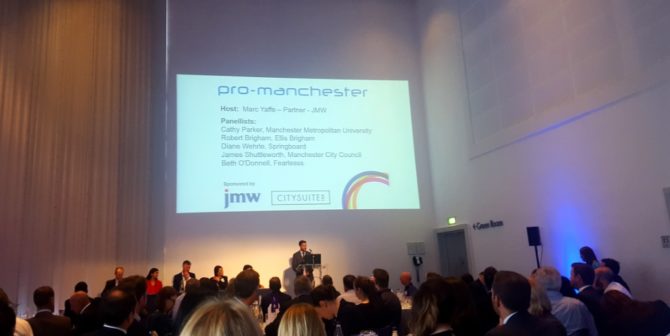Pro-Manchester Retail & E-commerce Lunch

On Wednesday, myself and some of our UK Shopping Centre team attended Pro-Manchester’s Retail and E-commerce Lunch at the Bridgewater Hall. Professor Cathy Parker and her team at Manchester Metropolitan University revealed their important findings and held a panel discussion revolving around how retail must adapt for the future.
Is footfall the biggest indication of success?
During the panel discussion, it was argued that footfall is the best indicator of success but must be balanced with economic KPIs. The developments in technology have enabled research to be carried out by Springboard, measuring footfall across 200 towns and cities, every hour of every day, with results showing a distinct correlation across the UK between footfall and sales success.
Robert Brigham from Ellis Brigham said ‘Footfall data gives an indication of opportunity but doesn’t tell you the full story.’ A decline in footfall doesn’t mean you can’t do business, but, you have to be smart and understand who is walking past the door and service their needs. This may mean further adaptation to certain locations; understanding what the customer wants and filling the shop and displays with the right products and promotions.
Footfall has increased massively post 5pm. This increase is due to F&B and leisure tenants in and around schemes – we now visit schemes for the experience, we go there to meet friends, do activities – not just for shopping.
Is online taking over bricks and mortar?
Online presents an opportunity for retailers to test the market without the cost and risk of opening a store. However, Diane from Springboard said ‘online represents 15% of spend – the majority of spend is in bricks and mortar but, online has affected the way we behave’. It is clear online is very popular, however, with 85% of purchases being made in-store, it undoubtedly presents the case for physical stores.
Cathy said, despite this so-called challenge between online and bricks and mortar, people are actually shopping and spending more because of the multi-channel options – if businesses can get the right blend they will prosper. An example of this is click & collect – retailers can use this online tool to drive their own footfall.
Some businesses are doing the opposite; having a physical store but no online presence. This strategy has derived from the business model all about low value and high volume, brands include Primark and B&M. But, the question raised was: can they continue to be successful in the future without an online platform?
Pop-Ups
The panel also discussed the value that pop-ups and short term leasing can add to our cities and towns. We need to stop being so fixed and permanent about space. Pop–up stores reduce the barriers to entry for new retailers and allow them to test the market though a temporary presence in shopping centres and high streets. Research found a 26% increase in footfall on market/event days, demonstrating the power of temporary events or stores and highlighting the importance of allocating space for them. The more flexible landlords are becoming, the more dynamic our towns and cities are too.
Convenience is key
Convenience is now a crucial factor for customers: same day delivery isn’t always the answer, with consumers at work and unable to accept delivery. What they want instead, is the option to choose when, where and how the order is delivered or collected.
The increased importance of convenience has made retail parks pose a bigger threat to high streets and shopping centres as they offer parking outside the shop door, easy access away from busy built up areas, and an increasingly balanced offering of retail, leisure and F&B to cater for all consumer needs.
How can councils help?
Creating stronger out of town centres is a great way to increase retail performance. Councils can help by ensuring they provide opportunities for entrepreneurs to establish and grow their businesses in outer-city hubs, providing housing and retail areas for commerce to flourish. If councils can build and create houses nearby, it will encourage higher footfall as the retail area will be conveniently located. In the same sense, Councils must ensure infrastructure is established to support travel in and out of major areas, with more people turning to public transport including buses, trains and trams.
The concept of Business Improvement Districts is also an important factor in driving cities and towns forward, and just as retailers have pulled together in different cities and towns to drive economic performance, landlords can do this too. If landlords see an opportunity for economic growth by investing to make a particular area of the city different, such as a leisure quarter or residential quarter, it will really help drive the footfall in retail space.
BREXIT
The lunch was closed touching on BREXIT. BREXIT will undoubtedly raise some uncertainty, but so far the retail industry appears to be performing strongly. Robert was very pragmatic on this topic saying ‘as one door shuts and another opens’: tourism is up, use this opportunity.
I think this is a great way of looking at the change – be positive, look for opportunities and change your strategy to keep momentum and drive the market forwards.
Shaunagh Durkin, Shopping Centre & Venue Management, Foundation Recruitment
